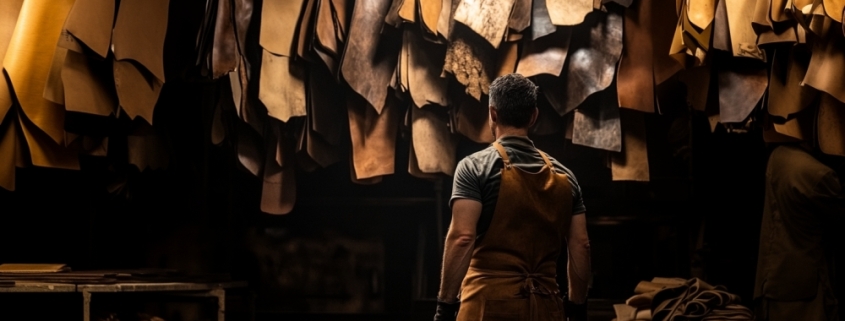The Impossibility of Producing Vegan Leather
In recent years, the term “vegan leather” has gained significant traction in the fashion and textile industries as an alternative to traditional animal-derived leather. Marketed as a cruelty-free and environmentally friendly option, vegan leather appeals to a growing demographic of consumers seeking ethical and sustainable products.
However, despite its popularity and the advances in material science, the production of vegan leather presents substantial challenges that call into question the viability of the term itself. This essay explores why producing vegan leather is fraught with difficulties, examining the materials used, the environmental implications, and the fundamental issues underlying the production process.
So What is Vegan Leather?
Definitions and Types
Vegan leather is a term used to describe synthetic or alternative materials designed to mimic the appearance and texture of traditional animal leather. The primary goal is to provide an ethical and environmentally friendly option without using animal hides. Vegan leather comes in several forms:
- Polyurethane (PU) Leather:Made from a polymer coating applied to a base fabric, such as polyester.
- Polyvinyl Chloride (PVC) Leather:Produced from a plastic coating that gives it a leather-like finish.
- Bio-based Leathers:Lighter alternative to steel, providing similar protection.
- Metatarsal Boots:These include materials derived from plant-based sources, such as pineapple leaves (Piñatex), apple peels, or mushrooms (MycoLeather).
Each type of vegan leather has its own production process, benefits, and limitations, but they all face significant challenges that contribute to the argument that vegan leather is essentially impossible to produce sustainably.
The Production Challenges of Vegan Leather
Synthetic Alternatives: PU and PVC
Polyurethane (PU) Leather
PU leather is a popular alternative due to its similarity to genuine leather and its lower cost. However, its production is not without problems:
- Chemical Composition:PU leather involves the use of chemicals such as diisocyanates, solvents, and plasticizers. These chemicals are not only hazardous to human health but also contribute to environmental pollution during production.
- Environmental Impact:Despite being marketed as eco-friendly, the manufacturing process of PU leather is resource-intensive. It requires significant amounts of energy and produces greenhouse gases. The production of PU also involves toxic emissions that can affect air and water quality.
- Durability Issues:PU leather often lacks the durability and breathability of genuine leather, leading to concerns about its long-term sustainability.
Polyvinyl Chloride (PVC) Leather
PVC leather is another common synthetic alternative, but it also poses several challenges:
- Toxicity:The production of PVC leather involves the use of chlorine and other harmful chemicals, which can result in the release of dioxins and phthalates. These substances are known to be harmful to both human health and the environment.
- Environmental Concerns: PVC is not biodegradable and can persist in the environment for hundreds of years. Its production also involves high energy consumption and significant CO2 emissions.
- Limited Recyclability:PVC leather is challenging to recycle due to the complex chemical composition, which further exacerbates its environmental impact.
Bio-based Alternatives: Piñatex, Apple Leather, and MycoLeather
Piñatex (Pineapple Leaf Fiber)
Piñatex is derived from the fibers of pineapple leaves and is often touted as a sustainable option. However, it faces several issues:
- Resource-Intensive Production:While the raw material is a byproduct of pineapple farming, the production process of Piñatex involves extensive chemical treatments to enhance durability and flexibility. These chemicals can be harmful and negate some of the environmental benefits.
- Limited Supply:The availability of pineapple leaves may not be sufficient to meet the growing demand for Piñatex, leading to potential supply chain issues and increased environmental pressure.
- Performance Limitations:Piñatex often falls short in terms of durability and flexibility compared to traditional leather, which may limit its practical
Apple Leather
Apple leather is made from apple pomace, a byproduct of apple juice production. Despite its promising aspects, it has several limitations:
- Processing Complexity: The production of apple leather involves combining apple fibers with synthetic binders and coatings, which can introduce additional environmental and health concerns.
- Durability Concerns:Apple leather’s performance can be inconsistent, particularly regarding its longevity and resistance to wear and tear.
MycoLeather (Mushroom Leather)
MycoLeather is produced from fungal mycelium and offers a biodegradable alternative. However, it faces challenges such as:
- Scalability:Producing MycoLeather on a large scale remains a significant challenge. The cultivation process requires controlled conditions and may not yet be able to meet the demand for large-scale production.
- Processing Needs:The production process involves specific treatments to ensure durability and aesthetic qualities, which can introduce additional environmental impacts.
- Cost Issues:The current cost of MycoLeather is relatively high, which may limit its adoption in mainstream markets.
What are the Environmental Implications of Vegan Leather Production?
Resource Use and Energy Consumption
The production of both synthetic and bio-based vegan leathers requires substantial amounts of resources and energy. The extraction of raw materials, the manufacturing process, and the transportation of finished products all contribute to environmental degradation. For example, the production of PU and PVC leather involves significant energy use, contributing to carbon emissions. Similarly, while bio-based materials like Piñatex and MycoLeather utilize renewable resources, their processing can be energy-intensive and involve chemicals that impact the environment.
Waste and End-of-Life Considerations
One of the critical challenges of vegan leather is its end-of-life disposal:
- Synthetic Vegan Leathers:Materials like PU and PVC are not biodegradable and can persist in landfills for extended periods. Their disposal can lead to environmental pollution, as they release toxins into the soil and water.
- Bio-based Vegan Leathers:While bio-based options like MycoLeather and Piñatex are designed to be more environmentally friendly, their actual degradation processes depend on specific conditions. If not properly managed, they may still contribute to landfill waste.
Ethical Considerations and Consumer Perceptions
Ethical Implications
While vegan leather is marketed as a cruelty-free alternative, the production processes involved can raise ethical concerns:
- Chemical Use:The use of hazardous chemicals in synthetic vegan leathers raises questions about the safety of workers involved in production and the impact on surrounding communities.
- Animal Welfare:Some argue that even though vegan leather avoids the use of animal products, the environmental and ethical issues associated with its production can undermine the broader goals of animal welfare.
Consumer Perceptions and Misconceptions
The term “vegan leather” can be misleading, as it implies a product that is both environmentally friendly and ethical. However, the reality is more complex:
- Greenwashing:Companies may use the vegan leather label to market their products as sustainable without addressing the underlying environmental issues. This can mislead consumers who are seeking genuinely eco-friendly options.
- Informed Choices:Educating consumers about the true environmental and ethical implications of vegan leather is crucial for making informed purchasing decisions.
Future Directions and Potential Solutions
Advances in Material Science
To address the challenges associated with vegan leather, advancements in material science are essential:
- Developing Sustainable Alternatives:Research into new materials that offer both ethical and environmental benefits could lead to more viable vegan leather options. For example, innovations in algae-based materials or fully biodegradable composites may provide more sustainable solutions.
- Improving Recycling Technologies:Enhancing the recyclability of synthetic vegan leathers could mitigate some of their environmental impacts. Developing closed-loop recycling systems and improving waste management practices are crucial for reducing the overall footprint.
Industry and Consumer Responsibility
Addressing the challenges of vegan leather production requires collaboration between the industry and consumers:
- Industry Initiatives:Companies should focus on transparent practices, investing in research and development to create genuinely sustainable products. They should also work on improving the environmental impact of their supply chains.
- Consumer Awareness:Raising awareness about the complexities of vegan leather and encouraging consumers to make informed choices can drive demand for more sustainable and ethical alternatives.
So What Now For Vegan Leather?
The production of vegan leather presents significant challenges that question the feasibility of its claim to be a truly sustainable and ethical alternative to traditional leather. While vegan leather offers some advantages, such as avoiding animal cruelty, it also involves substantial environmental and ethical issues related to the materials used, production processes, and end-of-life disposal. As the demand for ethical and eco-friendly products continues to rise, it is crucial for the industry to address these challenges through innovation, transparency, and improved practices. Only through a concerted effort to develop genuinely sustainable alternatives and educate consumers can the promise of vegan leather be realized in a meaningful way.
For a chat about your work forces safety boot requirements please give us a call on +27 11 892 8030 / 8031 / 8032 or drop an email to organise a call info@profitfootwear.co.za






